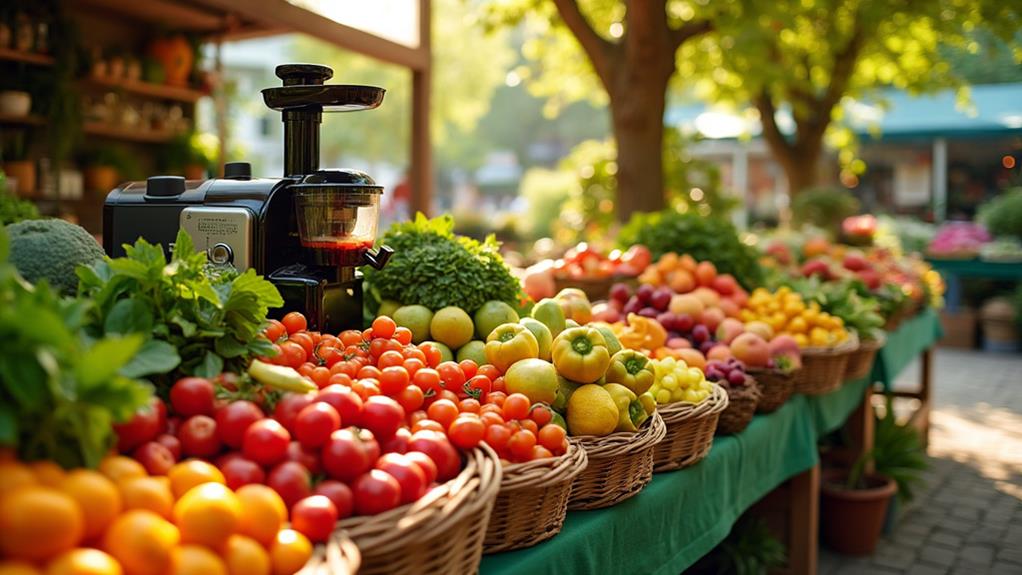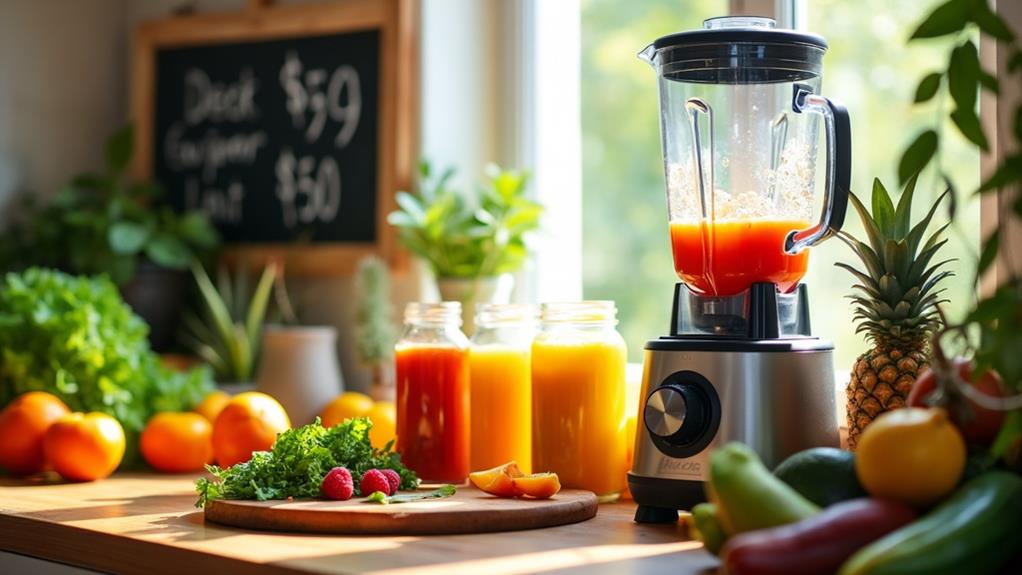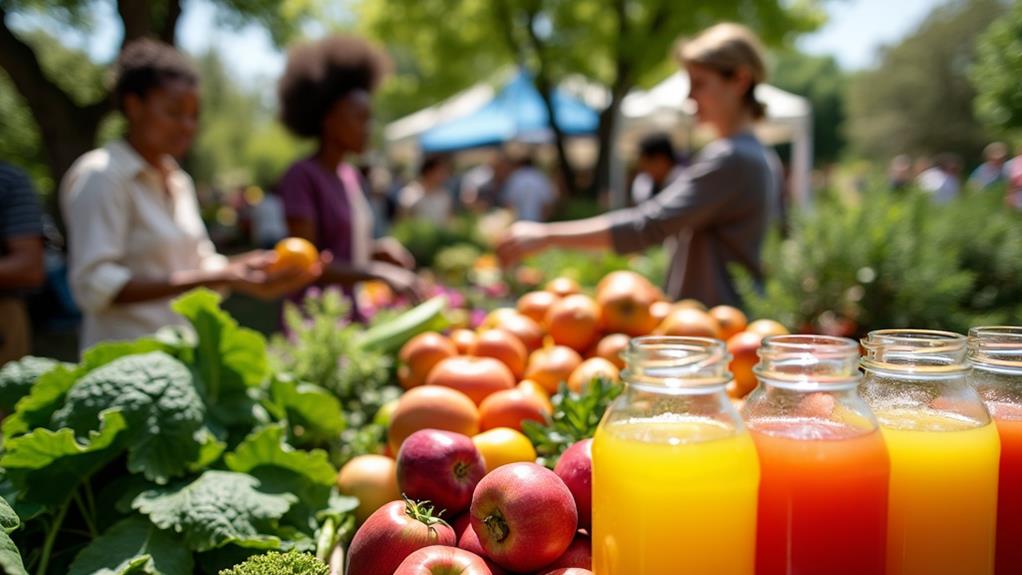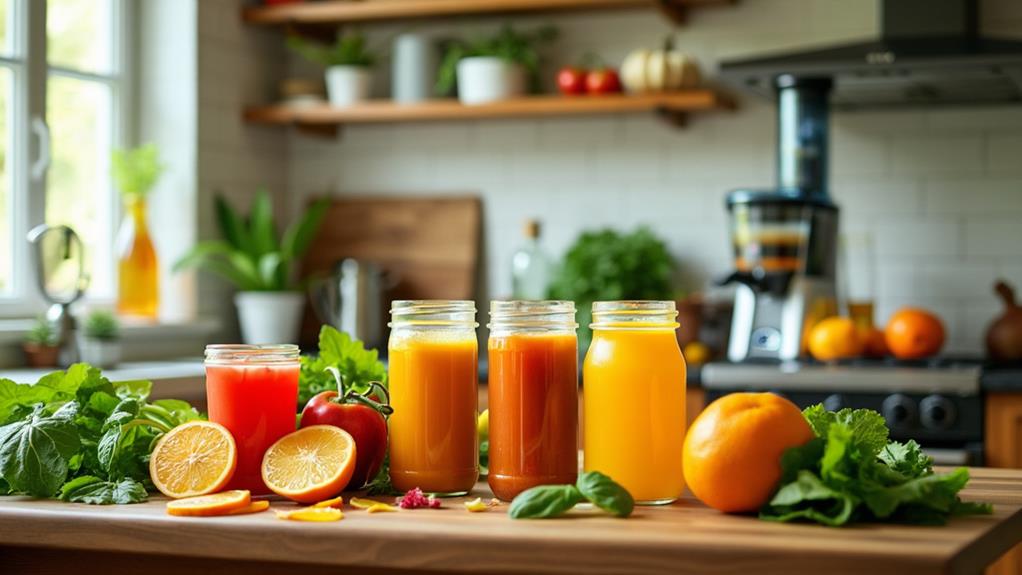Affordable Ways to Enjoy Organic Juice

If you want to enjoy organic juice affordably, start by planning a weekly juice routine and sticking to cost-effective recipes. Buy seasonal produce from farmers' markets or join a local co-op for discounts. Consider using high-water content fruits and in-season options to enhance yield and flavor without overspending. Don't forget to bulk wash and prep your ingredients to save time and reduce waste. You can also buy in bulk from membership clubs for extra savings. Ultimately, use leftover pulp creatively in dishes to optimize use. Investigate these methods further to integrate organic juice into your lifestyle budget.
Planning Your Juice Routine
To effectively plan your juice routine, start by creating a weekly juice plan with specific recipes, which will streamline your shopping and ingredient prep, saving both time and money. By setting aside time to organize your juice recipes, you can efficiently manage your meal prep and stick to your grocery budget. This approach helps you avoid impulse purchases and guarantees you have all the necessary ingredients ready for the week.
Utilize resources like the Juice Club, which offers organized shopping lists and a variety of juice recipes. These tools help you plan your meals and control your grocery budget by preventing unnecessary expenses. You'll find that having a structured plan allows you to prepare juices in bulk, reducing daily preparation time and costs. This method guarantees you always have fresh juice available without the hassle of daily juicing.
Incorporate bulk washing and prepping of ingredients into your routine. Doing so minimizes waste and optimizes efficiency throughout the week. Setting a specific budget for your juice routine and tracking spending lets you identify areas for cost reduction. This keeps you committed to your planned purchases, guaranteeing an affordable and healthy juicing experience.
Finding Cost-Effective Produce
Steering through the world of organic produce doesn't have to break the bank. To keep juicing on a budget, focus on buying seasonal fruits and vegetables. They're typically more abundant and less expensive, providing cost-effective options for your juice recipes. Seasonal produce not only saves money but also guarantees you're getting the freshest flavors.
Consider joining local co-ops or community-supported agriculture (CSA) programs. These offer a direct line to fresh produce from local farmers at prices lower than conventional grocery stores. It's a great way to support your community while keeping your juicing costs down.
Shopping at farmers' markets is another effective strategy. Here, you can find fresh, locally grown organic produce. Prices are often more competitive, and you can negotiate for bulk purchases, making it an ideal spot for juicing on a budget.
Don't overlook the benefits of purchasing bulk produce from membership clubs like Costco or Sam's Club. They offer discounts on organic items, helping you save even more.
Lastly, frozen organic fruits and vegetables can be more affordable than fresh options. They reduce waste and retain nutritional benefits, making your juices both economical and healthful.
Smart Budgeting Strategies

In regard to juicing on a budget, smart budgeting strategies are essential. To enjoy organic juice affordably, begin by setting a clear weekly budget for your juice ingredients. Aim to allocate around 10-15% of your total grocery budget to guarantee consistent access to fresh, organic produce without overspending. Here are some strategies to help you stay on track:
- Monitor Discounts: Keep an eye on local grocery store flyers and digital apps for discounts and sales on organic produce. By doing this, you can save an average of 20-30% on your weekly purchases.
- Join a Co-op or CSA: Consider joining a local co-op or community-supported agriculture (CSA) program. These options often provide organic produce at lower prices than traditional stores, offering savings of up to 50%.
- Buy in Bulk: Purchasing in bulk from membership warehouse stores like Costco or Sam's Club can notably cut costs. Organic fruits and vegetables are generally cheaper in bulk, helping you save over time.
- Implement Meal Planning: Incorporate juicing into your meal planning. Preparing a weekly schedule reduces impulse buys and guarantees you only purchase what's necessary, potentially lowering food costs by up to 25%.
Maximizing Juice Ingredients
Incorporating high-water content fruits and vegetables, such as cucumbers and watermelon, into your juices can greatly increase yield and reduce costs per serving. These ingredients not only stretch your juice further but also add a revitalizing taste and vital nutrients. For a nutrient-rich base, use leafy greens like spinach and kale, often available in bulk at lower prices. They're packed with vitamins and minerals, making your juice not only affordable but healthy.
When choosing your fruits, go for in-season varieties like apples and oranges. They're cheaper, fresher, and improve the flavor of your juice with minimal expense. Try experimenting with combinations like apple-carrot-beet blends to keep your juices exciting and diverse without needing to buy new ingredients. This approach allows you to enjoy a variety of flavors while staying budget-conscious.
Don't let the leftover pulp go to waste. Instead, get creative by incorporating it into recipes like muffins or crackers. This helps reduce food waste and guarantees you optimize every bit of your fruits and vegetables. By strategically selecting and utilizing your ingredients, you can enjoy delicious organic juice without breaking the bank.
Community Support and Resources

While maximizing juice ingredients can save you money, tapping into community support and resources takes your savings to the next level. By engaging with your local community, you can access organic produce at a fraction of the cost found in regular grocery stores. Here's how you can take advantage of these opportunities:
- Community Gardens: Join a community garden to grow your own organic produce. This not only cuts down on costs but also lets you enjoy fresh ingredients right from your backyard. Plus, it's a great way to connect with fellow gardening enthusiasts.
- Farmers Markets: Visit farmers markets in your city to find organic fruits and vegetables often priced lower than supermarket offerings. These markets offer a chance to buy fresh, seasonal produce directly from local growers, supporting their businesses and your juicing habits simultaneously.
- Local Co-ops: Become a member of a local co-op. Co-ops often provide organic produce at reduced prices by cutting out middlemen, making them an excellent resource for budget-conscious juicers.
- Online Juicing Communities: Engage with online communities to exchange tips on sourcing affordable organic ingredients. Members frequently share information about seasonal deals and discounts from local farmers, helping you save even more.
Creative Uses for Juice Pulp
Juice pulp, often seen as a byproduct, offers numerous creative possibilities that can enrich your culinary adventures. Instead of tossing it out, you can turn juice pulp into a wealth of whole foods. Packed with fiber and nutrients, it's perfect for enhancing recipes like muffins, breads, and crackers. Imagine incorporating a burst of flavor and texture to your baked goods at no extra cost! Not only does this practice reduce food waste, but it also raises the nutritional value of your homemade treats.
Looking to add more depth to your soups and sauces? Stir in some leftover juice pulp for an extra layer of flavor and a thicker consistency. This simple enhancement can transform a basic dish into something special while helping you minimize waste. If you're into snacks, consider dehydrating the pulp to make savory crackers or vegetable chips. These homemade delights are both healthy and satisfying.
You can even uplift your smoothies by mixing in pulp, which not only thickens the drink but also increases its fiber content. And for those committed to a zero-waste lifestyle, composting or using pulp as animal feed supports sustainability. Juice pulp is truly a versatile asset in the kitchen.




